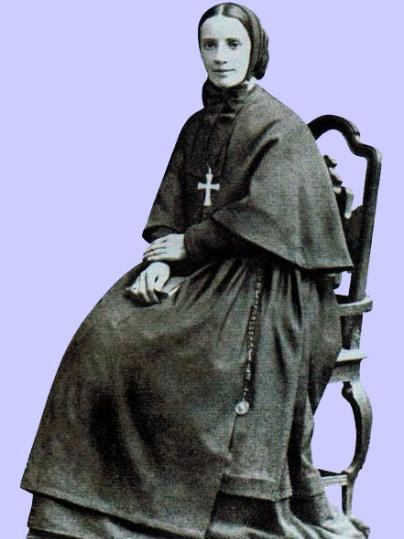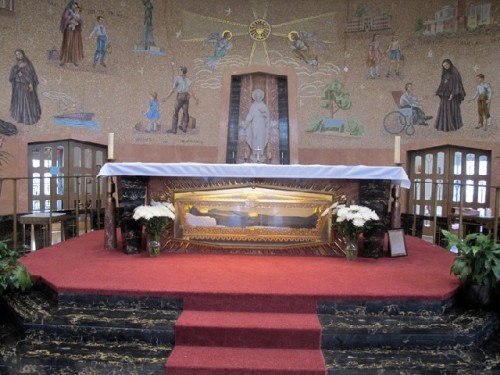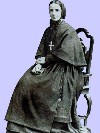Mick Rampartha is an oddball experimental American poet. Most of his work is in haiku form and plays with the most banal and primitive attributes of life. A few weeks before he brought me to the Mother Cabrini Shrine and the Cloisters, Mick had his prostate removed. I was the first person to visit him at the hospital. Flash forward a couple weeks, and I met him again, outside the subway station, ready to explore the grounds of his favorite place to meditate. Mick made jokes about the Depend diaper he was wearing, snorted with laughter and explained, “I just keep dribbling…” as we walked toward the Mother Cabrini Shrine.
I wondered why he was so bent on showing me a dead nun. I figured it’d be a weird and slightly off-color joke, like the kegel-exercise jokes he kept telling me now that his doctor had put him on a regimented plan to regain penile control. I felt a bit creeped out; I was about to gawk at a mummified nun put on display by a religion I found frightening. Knowing Mick the way I do, I imagine he took me because he is fascinated with religion, occult oddities, ancient art, and repulsed by the powerful, seemingly never-ceasing homophobia, sexism, racism, classicism and general disregard for people not participating within its’ power structure. Mick explained that a friend of his first took him on the same trek in the early 1980′s: the Mother Cabrini Shrine, the Cloisters, and then the Piper’s Kilt for beer and burgers. It’s nice to know some places have survived gentrification.
The Cloisters opened in 1934, 17 years after Mother Cabrini’s death, which was the same year John D. Rockefeller, Jr. started the project. The more I look at this seemingly quiet corner of Manhattan, I believe both the Cloisters and the Mother Cabrini Shrine have significant allegiances to old European religious power—a coded, out-in-the-open symbol of allegiance to pre-democratic ideals—while also standing as symbols of American possibility.
Once inside the Mother Cabrini sanctuary I found myself transfixed by her mummified corpse. I wondered: How does anyone worship God in this space? What is it like to take communion with a mummified corpse in the same room? Then I noticed the late afternoon light pouring through the stain glass representation of her on the back wall of the sanctuary. The light poured across the room with the full spectrum of color, it flooded the pews, and led my eye back to her remains.
The experience suggested the room is a connected architectural choice. Wrapped around the curved wall behind her altar is a simple mural: images of Mother Cabrini with Sisters, Angels, Christ, and common folks. Mother Cabrini was known to be quite humble and simple—yet the display of her corpse is everything but… Before exiting we poked around the official Mother Cabrini gift shop. I bought her biography.
Down the block, I felt overwhelmed. Mother Cabrini’s fate didn’t seem deserved. It seemed like a punishment, possibly, for being a radically helpful woman. She had little desire for personal possessions, yet in death she’s a caged memento of the empire she served. And as she remains there, forever part of the Church’s propaganda, the services she fought for and devoted her life toward have, for the most part, gone under-funded and closed down.
Mother Cabrini, and 6 of her Sisters from the Institute they founded in Italy, arrived in New York City on March 31, 1889. They were immediately greeted by the city’s infamously rough side. Mother Cabrini wasn’t necessarily running around with winos getting blitzed on leftover wine sludge in Opium Dens, like those described by Luc Sante’s portrait of New York City, Low Life. But she did discover they were homeless—temporarily, anyway. Due to a miscommunication, the Archbishop didn’t expect them for several months, and suggested they had no need for the Sisters—they ought to return to Europe.
Mother Cabrini demanded the Archbishop provide housing and showed him a sealed letter from the Pope. He relented and found a boarding house for their first night. Upon settling in, they discovered their first bed infested with bedbugs. The legend goes, the Sisters shuddered at the crawling sheets and took turns sleeping in chairs as Mother Cabrini knelt in prayer and steadfastly chanted into the morning. She “discovered by experience that difficulties and discouragements at the outset showed that success was to follow.”
Once the Sisterhood settled, Mother Cabrini met Mary Reid, wife of Count Palma di Cesnola, an exile from Risorgimento who was director at the Metropolitan Museum of Art. Mary bought the Sisterhood a house at 43 East 59th Street. Initially the Archbishop scorned the Sisterhood and demanded they not use the house as an orphanage. He suggested they start in Little Italy. At the time, Irish Clergy held power in New York. But the two women succeeded in convincing him to give them a chance, and founded the orphanage. Moving the Sisterhood from the Italian ghetto into a premiere neighborhood attracted notice and led to increased support for Mother Cabrini’s mission.
Today, the orphanage is located in West Park, New York, and is known as the Saint Cabrini Home—the first of 67 institutions Cabrini would go on to found in New York, Chicago, Des Plaines, Seattle, New Orleans, Denver, Golden, Los Angeles, Philadelphia, and in countries throughout South America and Europe. Her institutions served the sick, the poor and trained additional Sisters to carry on the mission.
I imagine Mother Cabrini consoling widows and newly orphaned children who’ve lost everything. Mother Cabrini was part of many efforts the Church made to bring Italian immigrants in America back to Catholicism. When she arrived in New York nearly 50 years before, Italian families had begun giving up on the Church, because of the unfamiliar Irish Catholic customs dominating the discourse. In Italy, attending Church was free, but in New York there was an enforced door fee of 10 cents—a large sum for immigrants, and a reminder they were to appease America’s god: Capitalism. I imagine Mother Cabrini’s country accent and matriarchal witticisms reminded those she touched of a simplicity they unknowingly left in Italy.
Mother Cabrini died of complications from dysentery at 67, in Columbus Hospital, Chicago, on December 22, 1917, while preparing Christmas candy for local children. By then, she’d achieved regard for healing miracles, which she’s purported to have worked through obedience and relentless prayer.
Since her death, people claim to have manifested miracles by praying to her. Because of this, she became a candidate for the canonization process. In 1931 her remains were exhumed and she was discovered to be a partially incorrupt corpse; and then officially declared a Saint. Since then the majority of her body has been held at the Mother Cabrini Shrine; her heart was sent to the site of the first Institute she founded in Codogno, Italy; a piece of her arm is in Chicago; and her head was sent to the Motherhouse, adjacent the Vatican.
My friend Crystal grew up attending church at the Mother Cabrini Shrine during the 1990′s. Her Grandmother, a devout Catholic, made a promise to God that she’d always visit Mother Cabrini. Crystal’s Grandparents immigrated to Little Italy from the Dominican Republic in 1965. The family suspects she discovered Mother Cabrini in New York. But, it could’ve been as a child in the Dominican Republic. Crystal thinks her Grandmother has remained devoted because she is the Patron Saint of Immigrants. After arriving in Little Italy, her Grandparents moved to Bushwick and opened a Bodega. Throughout the 1960′s and 1970′s many friends and family members, immigrated and stayed at the apartment above the store. All the while, Crystals’ Grandmother kept a photograph of Mother Cabrini on the mantel and often made the trek to her favorite Saint.
For Crystal, growing up with a mummified body was different. She comes from a large family, so funerals happen regularly; because many showcase open caskets, dead bodies become normalized. Seeing the body of some lady—and that’s all Mother Cabrini represented to her as a child—proved to be less shocking than a friend or relative’s. And because she’s on the altar wearing a habit, Crystal thought she was a statue. Around 10, Crystal mustered the gumption to go into the gift shop and ask the nun behind the register if Mother Cabrini was real. Crystal reasoned a nun wouldn’t lie. Her Grandfather teased her about the mummy, and she wanted to prove him wrong. But the nun verified Mother Cabrini’s body. She recalls feeling freaked out because she spent a lot of time at the altar with her Grandmother. She’d be there praying and Crystal would pretend to pray, but in actuality was transfixed by the mummy. Once Crystal understood it to be a real body, she went home and demanded her Mom remove all the Mother Cabrini memorabilia from her room. At the time she was obsessed with Michael Jackson’s HIStory album. Inside the album is a photo of a young girl with bandages over her eyes. Young Crystal’s imagination superimposed Mother Cabrini’s eyes over the bandages, and has since been terrified.
Just before my deadline, I made a last trek to Mother Cabrini to take photos. I read Jose Munoz’s Disidentifications: Queers of Color and the Performance of Politics as I rode the subway uptown. A “closed” sign startled me when I arrived. I peaked through the window and pulled on a cigarette as a woman opened the door. She asked if I was there to see Mother Cabrini. “Yes,” I briefly explained the article. Her face lit up as she invited me inside. Immediately, she let me know how badly press was needed, that the sanctuary needed repairs and that interest in Mother Cabrini has drastically waned. She smiled as she pointed toward her.
I asked if she knew anything about the origins of the mural. She shook her head. Then exclaimed, “But isn’t it beautiful!” I smiled and began fidgeting with my camera. There was a pause. Then she told me a story about a person who had written an unfavorable article about Mother Cabrini. Then darted from the room. I got the sense I was worrying her.
I tried to snap a high quality photo; but realized there wasn’t a clear shot. The glass case displaying the body sits about 12 feet from a velvet rope placed to keep visitors out. I took a step back and tried to refocus the room, and hopefully find a way to capture its weirdness. Then it hit me—I had taken on an impossible project. Writing about a mummified nun for a small arts magazine focused on the intersections of art and the body was an absurd idea; sure to be the least read story ever. Simultaneously, I was dumbstruck by the magnitude of importance her devout followers placed upon her. The article seemed like it’d do little more than bore one group of readers, while outraging another.
Moments later, she reappeared saying I shouldn’t use photos for a published article without first speaking to the Head Sister. If the Head Sister felt the article portrayed Mother Cabrini in an appropriate way, she’d happily allow as many photos as needed. I shot Mother Cabrini an eye roll. Paused. Then I started to stammer about my desire to speak positively about Mother Cabrini’s life and work but yes, I was aiming to … see her through a feminist gaze … Inevitably critical of the Church, which uses her death for its own profit.
Sure, within the Catholic tradition the fate of Mother Cabrini’s corpse is considered a high honor. She’s been canonized, idolized, immortalized and mummified, but how does this parlay into her desire for simplicity and direct action? She lived a humble life, so why a grandiose, highly public, constant viewing of her mummified corpse? I imagine Mother Cabrini asking, “How do these excesses help serve the missions?” She gave me a long, confused look before I broke and agreed to meet the Head Sister. As the words came, I wondered what the fuck had happened to me. And then, just as quickly, I had this fantasy playing out in my head that talking to the Head Sister might actually prove an interesting, worthwhile venture. I’d come this far, I reckoned.
But when I returned to meet her, the sanctuary was closed. It felt like I had been blessed.
I decided to wander the grounds and snapped photos of trees, statues, and odd memorabilia. I realized I was experiencing a joy I hadn’t experienced. It took a moment to decipher that it came with the knowledge that she was inside the sanctuary, exactly the same as my other visits. And she was the same when Crystal knelt before her with her Grandmother. I had developed an appreciation for reverence; she was one of a handful of things that I could rely on.
It felt silly, yet I stared at her bench placed against a brick wall near the parking lot adjacent to the sanctuary, and imagined her covered in orphans. Her belief in faith, simplicity, humility and obedience as the source of all spiritual power still doesn’t quite register with me. But I felt like I was beginning to grasp her desire for a reliable Sisterhood.
Recently, Sister Megan Rice found herself caught while pursuing justice. The Sister, along with two anti-war activists, revealed security flaws at a nuclear facility outside Knoxville, Tennessee. They broke in using bolt cutters and a hammer. They caused no permanent harm to the facilities. The group claims they were demonstrating the ineptitude of the lackadaisical security system protecting the facility; they were acting as concerned global citizens. Despite evidence, Sister Rice faces 30 years in prison. All I could think was, “Wow, again—a Sister fights for a better, more sustainable world, only to end up caged by the powerful.”
Reposted courtesy of Stephen Boyer and NY Arts Magazine.



